- 22 Minutes to read
- Print
- DarkLight
- PDF
22.4 Release Notes
- 22 Minutes to read
- Print
- DarkLight
- PDF
User Experience: Online Help
The online help has been created to
- Improve the overall user help experience
- Save time and effort spent in searching for content
- Simplify the online help navigation
- Provide an active feedback mechanism
You must use the help.planful.com URL for accessing the online help.
The existing online help URLs will no longer be available from the upcoming release, and you will need to update the existing bookmarks with the latest URLs.
The following are some of the significant features:
- A refreshing Homepage with excellent navigational and search capabilities
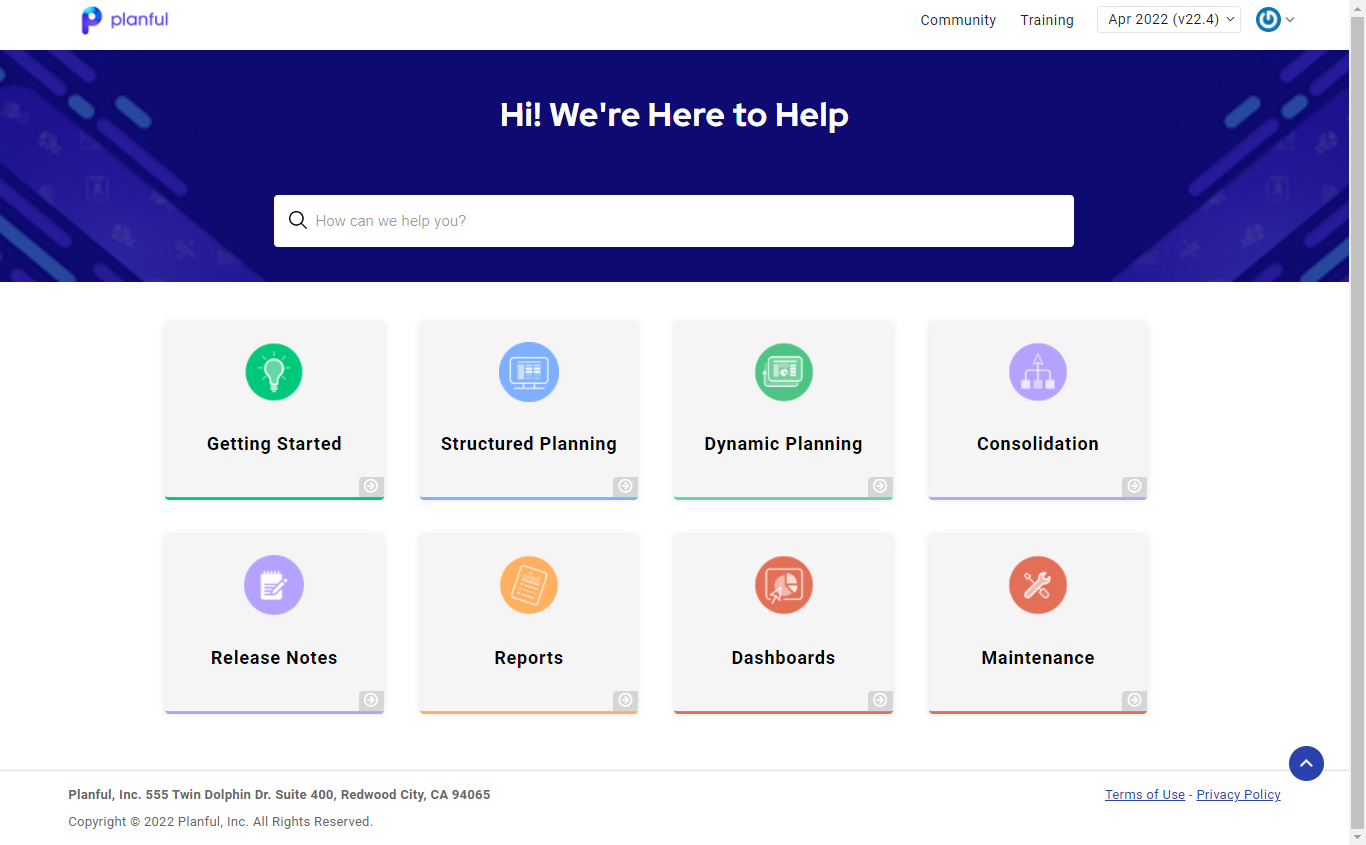
- Modern top navigation bar with the ability to switch between multiple versions of help. You can select any version as per your requirement to view the updates. For example, if the Production release is in March (22.3), select
- Mar 2022 (v22.3) to view the latest Production updates
- Feb 2022 (v22.2) to view the previous release updates
- Apr 2022 (v22.4) to view the latest Sandbox updates
.png)
- A Global Table of Contents to help navigate to different sections of the OLH
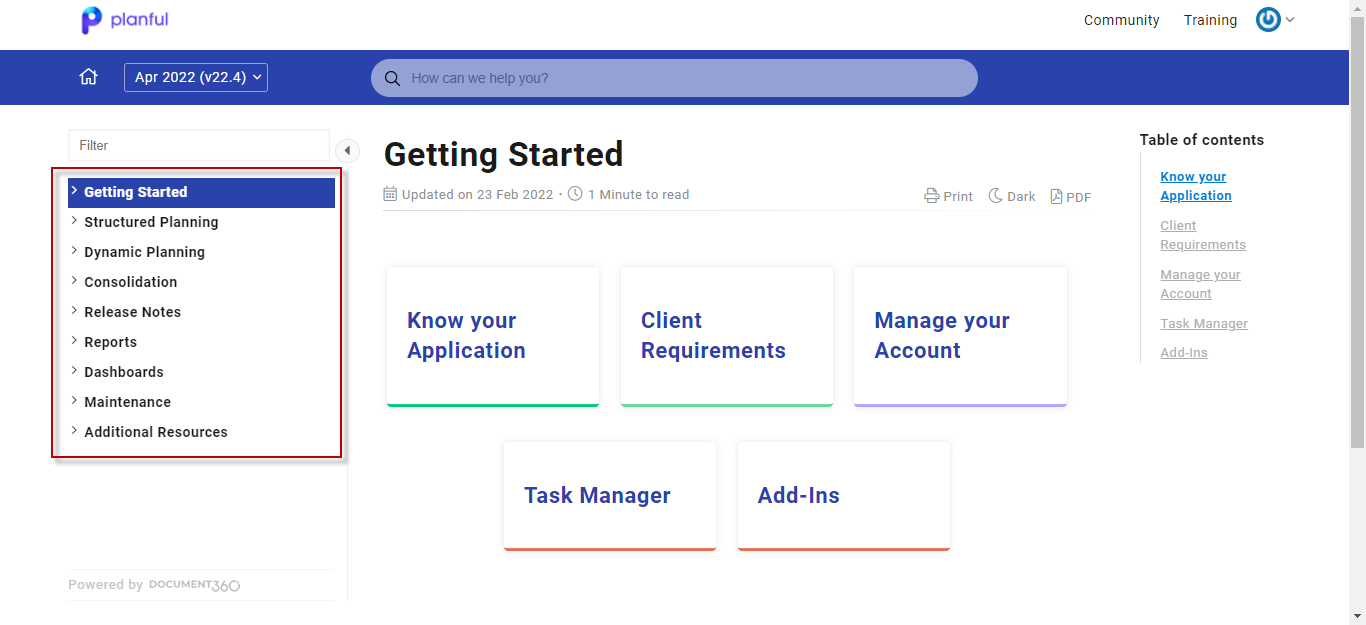
- An article specific Table of Contents to help navigate to different headings within the article
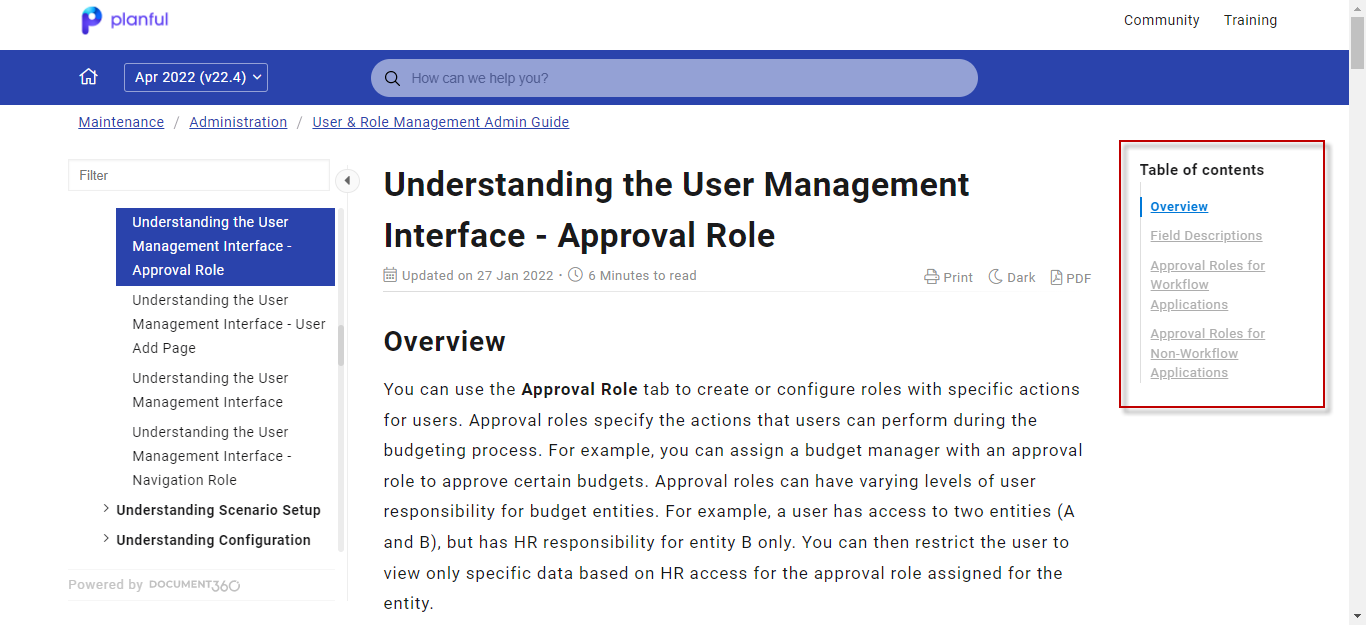
- Option to select the Reading mode based on the preference, for example, Light mode or Dark mode
- An advanced real-time search that looks for every word, phrase, or sentence that you type in the search bar, saving a lot of time and effort consumed previously searching for content
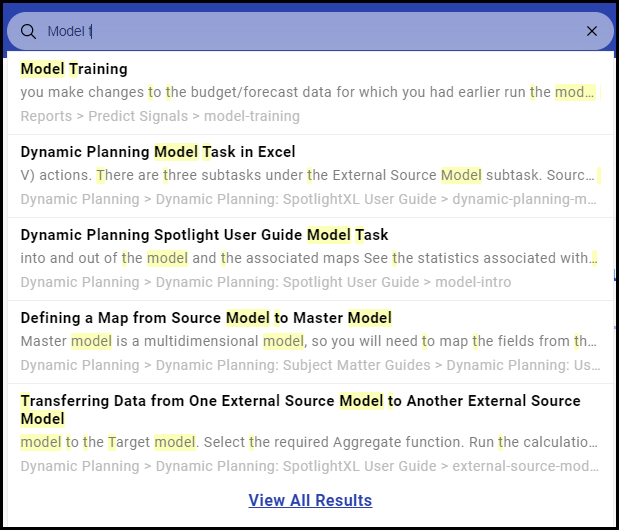
An active feedback mechanism with options to like articles, dislike articles, and provide discreet feedback for the content

Platform: Enhanced the Export Icon
With this release, you will see an intuitive icon on the following pages:
- Replaced the previous Kebab menu icon with the Excel and Print icons in the Substitution Variables tab of the Cube Settings page

- Removed the Export as Excel and Print options from the previous Kebab menu icon and replaced them with the Excel and Print icons in the toolbars of the Standard Reports page

- Replaced the previous Export icon with the Excel icon and a Print icon in the toolbars throughout the Workforce Setup page, the Asset Setup page, and the Global fields Setup page
Following is an illustration of the Workforce Setup page.
 Following is an illustration of the Asset Setup page.
Following is an illustration of the Asset Setup page. Following is an illustration of the Global fields Setup page.
Following is an illustration of the Global fields Setup page. Previously, the toolbars used to look like the following illustration.
Previously, the toolbars used to look like the following illustration.
Predict: Added the Refresh button functionality on Signals Admin Screen
With this release, you can refresh the Predict: Signals admin screen after starting any Predict process, such as Pre-computation or Model Training. Previously, you had to move out of the admin screen and come back to it to learn about the status of the Predict process you had started. The Refresh button enables you to refresh the page to know when the process is completed. You can then start another process or utilize the output of the Predict process that just ended.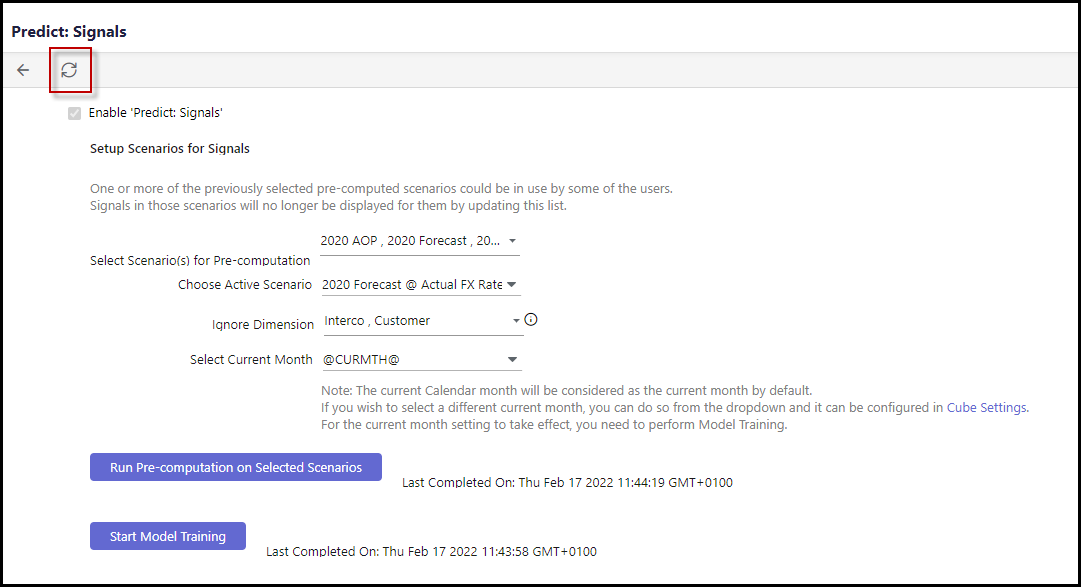
Structured Planning: Enhancement to Workforce Area in Clear Data Preview Screen
With this release, as an Admin user, you will be able to see up to 1000 rows of data in the Clear Data Preview Screen. Previously this limitation only existed in the Finance area, now with this release, it is applied to the Workforce area as well.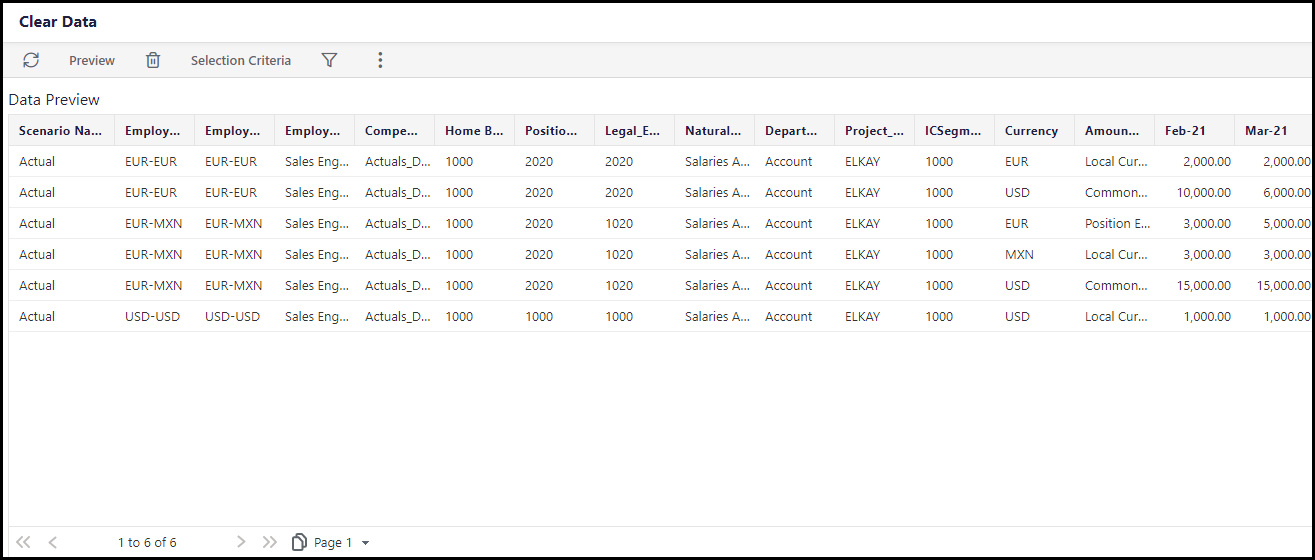
Dynamic Planning: Enhancement to Clear Data Performance Optimization
With this release, the ClearAllData Calculation step has been enhanced to process the data quickly, saving a lot of time working with extensive data calculations. Previously, the calculation step used to take a considerable amount of time to clear models with a large amount of data.
Dynamic Planning: Enhancement to Formula Performance Optimization
With this release, we have improved the performance of formula step calculations for all formula members. If the "Enable Formula Performance" flag is set to true, a new formula code will be applied, allowing you to calculate the formula reference for members based on specified keys. Formula creation with formula reference took longer for high-value dimension combinations. In addition, we improved the formula run-time by skipping a few overheads, significantly reducing the time and effort involved in the execution of formulas for separate formula members.
- To Enable the “Enable Formula Performance” Flag, please contact the planful support team.
- Performance optimization will be different for each model, based on its definition.
Platform: API to validate source segments for Translations
This API allows you to identify the source segments from the Source file based on the DLR definition. You can supply the related segment members to the Translations DLR by identifying the source segments.
Business Value
At present, the Translations DLR has to verify and validate the input file for source segment members required for the Translations mapping definitions. Along with this activity, the DLR has to run other validations like months and amounts provided in the input file simultaneously. These two steps take more time.
Adding a pre-step to validate mappings of source segments in the input file alone will improve the performance of the DLR and benefit the clients.
API Parameters
Method
POST
Endpoint Url Syntax
<<Application URL>>/translationdlr/verifysourcesegmentsAPI
Content Type
application/x-www-form-urlencoded
Sample Request Body
{ DataLoadRuleConfig:{ DataLoadRuleId: 667725, DataLoadRuleName:"test_trans_API", ColumnDelimiter: ",", RowDelimiter:"|", TextQualifier:"'" }, Payload: "SRC_SEG1,SRC_SEG2|Ac1,Cmp2|Ac2,Cmp1|Ac3,Cmp4|Ac4,Cmp3|Ac1,Cmp1|" }- Either DataLoadRuleId or DataLoadRuleName should be available.
- ColumnDelimiter is mandatory.
- RowDelimiter is a new Line(\n) by default if nothing is specified.
- TextQualifier is an optional parameter, and by default, it’s none.
- The first row in the payload must contain the source segments header info and in the form as SRC_SEG<<Segment number>> ex: SRC_SEG1, SRC_SEG2 etc.
Sample Responses
The Details (Message and rows details) section of the response will vary with the various conditions.
{
"DataloadId": 667725,
"DataLoadRuleName": "test_trans_API",
"Message": "The source segments validation is successful.",
"Details": [{
"Message": "Translation Details.",
"ColumnHeaders": [
"Row",
"Source Column 1",
"Source Column 2",
"Account",
"Company",
"Translation Name"
],
"Data": [
[
"1",
"Ac2",
"Cmp1",
"1943-YTD",
"2091LC",
"test_account , test_company"
],
[
"2",
"Ac16",
"Cmp2",
"4018-MTD",
"2092CC",
"test_account , test_company"
]
]
}
]
}
Failed Response
{
DataloadId: 667725,
DataLoadRuleName: "test_trans_API",
Message: "Validations for source segments failed.",
Details: [
{
Message: "A few segments are not part of the Translations Setup or DLR. Please verify and try again.",
ColumnHeaders: [
Row,
Source Column 1,
Source Column 2,
Translation Name
],
Data: [
[
1,
Ac1,
Cmp2,
test_comp_account_Company
],
[
2,
Ac2,
Cmp1,
test_comp_account_Company
],
[
3,
Ac3,
Cmp4,
test_comp_account_Company
],
[
4,
Ac4,
Cmp3,
test_comp_account_Company
]
]
}
]
}
Platform Enhancement: Removed Budget Entity Drop Down
Now, on the Select Template page, the drop-down option for the Budget Entity field is removed. This update is applicable for all template types except HR templates. These changes are visible in both Input and View modes. Additionally, the All Budget Entities option is added in the Budget Entity drop-down for HR Templates in the UI.
Business Value
The drop-down served no purpose as users can also use the tree structure to select the required Budget Entity. Moreover, the drop-down used to take time to load the list of budget entities if there were more entities. So, to improve the application performance, the drop-down is removed for the majority of template types.
In Practice: Navigate to Budget Entity Field
- Navigate to the Planning Control Panel and select a Scenario.
- Select the required hierarchy and select a template.
- From the Actions > Template Workflow section, select either View or Input. The template is displayed.
- Click the Select Template option, and you can see that the drop-down has been removed from the Budget Entity field.
Platform: Transfer Data Rest API
The Transfer Data rest API loads the data into the Planful database from the source database. You should perform the following steps to use the API:
- Generate The API Key
- Get the list of DLRs
- Transfer the Data
Generate the API Key
Generate an API Key and provide the same in the header to get the list of DLRs and transfer the data.
Method
POST
Endpoint Url Syntax
<Provide Application Url>/auth/login
Content Type
application/x-www-form-urlencoded
Sample Body
{
“Username”: “xyz@planful.com”,
“Password”: “Ayz@123”,
“TenantCode”: “Apr2021Demo”,
“ClientType”: “OfflinePlanning”
}
When you run this, an authorization key is generated. The generated key is valid for 2 hours.
Get the list of DLRs
You can use the following syntax to get the complete list of DLRs:
Method
GET
Endpoint Url Syntax
<Provide Application Url>/financemodel/data/rules
Headers
| Key | Value |
APIKey | Authorization Key |
Sample Response
[
{
"DataLoadRuleId": 600003,
"Name": "Account",
"LoadItem": "Segment Hierarchies"
}
]If you want to get the list of only GL Data DLRs, use the following endpoint URL syntax:
<Provide Application Url>/financemodel/data/rules/gl
If you want to get the list of only Transactions Data DLRs, use the following endpoint URL syntax:
<Provide Application Url>/financemodel/data/rules/transactions
Transfer the Data
You can transfer the data from the source database to the Planful database in either a single transfer or batches. If the # records are within the permissible limits, you can transfer the data in a single API call. If the # records are beyond the limits, you must make multiple API calls to send the data in batches.
Note
The data transfer honors the limits set for web services data loads. The default data transfer limit is set to 10,000 records for each request. Similarly, if the request size is more than 1 MB, the API returns the error message as 413 (entity too large).
Single Transfer
You can use either a POST method or a PUT method to transfer the data in a single API call.
Method
POST/PUT
Endpoint Url Syntax
<Provide Application Url>/financemodel/data/transfer
Headers
| Key | Value |
| APIKey | Authorization Key |
| IsLoadCompleted (applicable only for PUT Method) | True |
Body
{
"dataLoadRuleId": DataLoadId,
"dataLoadRuleName": "DataLoadRuleName",
"columnDelimiter": ",",
"rowDelimiter": "|",
"payload": "1,2|2,3|3,4|4,5|5,6|6,7|7,8|8,9|9,10"
}
Response
The response contains a success or a failure message with a GUID for tracking. If the API call is successful, the response code for Sync DLRs is 200 OK, and for Async DLRs, the response code is 202 Accepted.
Data Transfer in Batches
Following is the series of API calls you have to make transfer the data in batches:
Request 1
Method
PUT
Endpoint Url Syntax
<Provide Application Url>/financemodel/data/transfer
Headers
| Key | Value |
| APIKey | Authorization Key |
Body
{
"dataLoadRuleId": DataLoadId,
"dataLoadRuleName": "DataLoadRuleName",
"columnDelimiter": ",",
"rowDelimiter": "|",
"payload": "1,2|2,3|3,4|4,5|5,6|6,7|7,8|8,9|9,10"
}
Sample Body
{
"dataLoadRuleId": 600205,
"dataLoadRuleName": "REST1 WS GL Data",
"columnDelimiter": ",",
"rowDelimiter": "|",
"payload": "1,2|2,3|3,4|4,5|5,6|6,7|7,8|8,9|9,10"
}
Response
The response contains a success or a failure message with a GUID for tracking. If the API call is successful, the response code for Sync DLRs is 200 OK, and the response code for submission of Async DLRs request is 202 Accepted.
Request 2
Method
PUT
Endpoint Url Syntax
<Provide Application Url>/financemodel/data/transfer
Headers
| Key | Value |
APIKey | Authorization Key |
| DataLoadExecutionId (applicable only for PUT Method) | Provide the GUID generated in the previous request 1. |
Body
{
"dataLoadRuleId": DataLoadId,
"dataLoadRuleName": "DataLoadRuleName",
"columnDelimiter": ",",
"rowDelimiter": "|",
"payload": "1,2|2,3|3,4|4,5|5,6|6,7|7,8|8,9|9,10"
}
Sample Body
{
"dataLoadRuleId": 600205,
"dataLoadRuleName": "REST1 WS GL Data",
"columnDelimiter": ",",
"rowDelimiter": "|",
"payload": "1,2|2,3|3,4|4,5|5,6|6,7|7,8|8,9|9,10"
}
Response
200
Last Request
The request for the last batch of the data must have the following parameters:
Method
PUT
Endpoint Url Syntax
<Provide Application Url>/financemodel/data/transfer
Headers
| Key | Value |
| APIKey | Authorization Key |
| DataLoadExecutionId (applicable only for PUT Method) | Provide the GUID generated in the previous request 1. |
| IsLoadCompleted | True |
Body
{
"dataLoadRuleId": DataLoadId,
"dataLoadRuleName": "DataLoadRuleName",
"columnDelimiter": ",",
"rowDelimiter": "|",
"payload": "1,2|2,3|3,4|4,5|5,6|6,7|7,8|8,9|9,10"
}
Sample Body
{
"dataLoadRuleId": 600205,
"dataLoadRuleName": "REST1 WS GL Data",
"columnDelimiter": ",",
"rowDelimiter": "|",
"payload": "1,2|2,3|3,4|4,5|5,6|6,7|7,8|8,9|9,10"
}
Response
200
Platform: DLR Locking
This feature enhancement locks a DLR when two or more users simultaneously access the same DLR. For example, when the first user is accessing the DLR, a second user cannot execute the same DLR before the first user finishes the execution. A DLR lock is applied on the DLR when a user starts executing the DLR, and the lock is released after the first user finishes execution. Other users cannot execute the DLR during that time period, and a lock error message is shown to the second user. This avoids any concurrency issues that may occur when multiple users are accessing the same DLR simultaneously.
DLR Locking behavior:
In the current application setup, the data loads happen through Sync and Async loading process, and the DLR can be accessed in three different ways:
- SOAP APIs
- REST APIs
- Through UI
DLR locking is always applicable for Sync loads. However, for Async loads, certain scenarios have DLR locking relaxation. Here is the list of DLRs that are exempted from DLR locking during Async loads:
| DLR Name | Soap | REST | UI |
|---|---|---|---|
| GL | The lock is relaxed if the Horizon flag is enabled. | The lock is relaxed if the Horizon flag is enabled. | The lock is only relaxed if the Horizon flag is enabled and the file is uploaded on the last step. |
| Translations | The lock is relaxed if the Horizon flag is enabled. | The lock is relaxed if the Horizon flag is enabled. | The lock is only relaxed if the Horizon flag is enabled and the file is uploaded on the last step. |
| Employee Allocations | The lock is relaxed if the Horizon flag is enabled. | N/A | The lock is only relaxed if the Horizon flag is enabled and the file is uploaded on the last step. |
| Employee Compensations | The lock is relaxed if the Horizon flag is enabled. | N/A | The lock is only relaxed if the Horizon flag is enabled and the file is uploaded on the last step. |
| Segment Hierarchy (Common CCOA) | If Alternate Hierarchy is selected, the locking is relaxed. If Main Hierarchy is selected, the locking is relaxed if the Horizon flag is on | N/A | The locking is relaxed if Alternate Hierarchy is selected, and the file is uploaded on the last step. The locking is relaxed if Main Hierarchy is selected, the Horizon flag is enabled, and the file is uploaded on the last step |
Platform: Custom URL
Now, Planful customers can have a custom URL for their Planful application. You can create the URL based on the name of the company. For example, a custom Planful URL may look like xyz.planful.com.
This feature is available as an opt-in for the customers, and you can reach out to Planful Support to create a Custom URL for your application. If you use different URLs for Structured Planning and Dynamic Planning, you have to unify the URLs with OneLogin before the URL customization. For now, only "planful.com" sub-domain has custom URL support.
The following settings that you might have configured with the old URL are lost after you implement the custom URL. You have to reconfigure them again with the latest URL:
- The Remember User Name on the landing page is lost.
- The Remember password settings is lost.
- The cookie settings to remember the two Factor Authentication OTP is lost.
- Authenticator app configuration. You have to reconfigure the authenticator app.
- The notification settings are lost.
Limitations:
- After you have created a Custom URL, if you click any old link that was generated (the links in the email specifically related to Graffiti and Task Manager) before creating the Custom URL, the old link will not redirect you to the Custom URL. You will be redirected to the login page where you have to re-login to the application.
- If you have logged in to the application through Custom URL and received the following error message while trying to configure Box setup, please contact Planful's Support team to resolve the issue.
“redirect_uri_mismatch”
- Though you have configured Custom URL for your application, the standard system generated emails related to the following actions will have the old link:
- User locked - Invalid Attempts
- 2FA
- Forgot Password
- 90 days Expiry – Expired
- User Sync New User Add
- User Add from Admin
- User Unlock from Admin
- User - Send email from Admin
Note This snapshot URL fix will only work for the new snapshot links but not for the existing ones.
Platform: Introducing Ivy
Ivy is Planful’s proprietary framework for unified, smarter, and faster data handling across data integrations, planning, consolidation, and close processes in the Planful structured planning application. Ivy engine simplifies data collection, validation, processing, and reporting while ensuring security, accuracy, and consistency.
Limitations:
Ivy is currently not supported for applications where the configuration for Fiscal periods per year is greater than 12 periods or when Shared Mode is configured.
Guiding Principles
Ivy applies the following guiding principles for calculations:
- Ivy applies built-in computation to derive account balances across time periods in conjunction with the Scenario used. The balances are recomputed accurately for all the future periods when the data is entered in a non-chronological order. This is a major advancement over the legacy.
- Ivy recognizes the significance of no activity periods on specific account balances and brings out a unique way of handling the built-in calculations for no activity periods. The computations set MTD = 0 or YTD = 0 honoring the data input type property or Load type for Data load Rules. The account balances are calculated for the applicable periods within the fiscal year.
- Ivy computes and manages currency conversions depending on the currency configurations and exchange rates set up in the application. Currencies are calculated only when the exchange rates are provided for the scenario in the Planful application. It honors any currency exception configurations for the legal entity or account and the Currency computations are maintained for both MTD and YTD balances, depending on the account and the data input type.
- Ivy uses a Translation engine for faster data processing while using translations with your Structured planning data load rules. Note that when you have overlapping translations that qualify for the different mapping to your Planful chart of account segments, the Translation engine leverages the last mapping for the data load. For details on the Translation setup, click here.
- Ivy maintains an improved precision up to the 6th decimal value of all the numbers and calculations.
- In addition, Ivy enables Planful to offer more advanced features and functionality in the future. Below are some of the advanced features only available with the Ivy upgrade.
Additional Application Functionalities based on Ivy Framework
Planful customers who have upgraded to the Ivy framework will have a few additional functionalities supported in the application. The functionalities are as follows:
- Currency Conversion in Process Flows
- History in Drill Through reports
- Automatic Data Refresh
- Dynamic Journals MTD data posting support
Currency Conversions Option in Process Flow
The Currency Conversions option is available as a task type when creating a new Process Flow from the Cloud Scheduler > Process Flow screen. You must upgrade to Ivy to view the Currency Conversions option in the Task Type drop-down.
Business Value
Until now, multi-currency reporting was not available for Planful Structured Planning users, and the existing currency conversion process with consolidations was too slow resulting in a lag between the data loads and multi-currency reporting.
Adding Currency Conversions in Process Flow makes multi-currency reporting accessible to Structured Planning users. Now, the currency conversion process leverages the Ivy framework, resulting in faster processing time from Local to Common Currency, Interim Currencies, and Reporting currencies.
In Practice
Accessing Currency Conversions Task Type
- Go to Maintenance > Cloud Scheduler.
- Click the Process Flow tab.
- Click the Add Process Flow icon.
- Click the Tasks tab, and select the Task Type drop-down. You can view the Currency Conversions option added in the drop-down menu. Select Currency Conversions and provide the following information in the respective fields. These fields are mandatory:
- Task Name - This field is mandatory. It is automatically updated when you select a Scenario, Company, and Period. By default, the Scenario + Company + Period is taken as the Task name.
- Scenario - Click the icon adjacent to this field and select a scenario. The scenarios are listed based on your Scenario security settings. This field is mandatory.
- Company - Click the icon adjacent to this field. You can select a roll-up or leaf member. When you select a roll-up member, the currency conversions process happens to all the leaf members under the roll-up member. This field is mandatory.
- Period - Select a period from the list. You can run the currency conversions process for the selected period. The options available are Current Month, Previous Month, Current Financial Year, and Custom Period. When you select Custom Period, you can provide the From and To dates from the respective date pickers. This field is mandatory.
- Dependencies - Select any dependency if the currency conversion task is dependent on any other process.
- This field is optional.
- Email Recipients - You can provide the email address of the users to whom you want to send an email notification when the Currency Conversions are processed based on the Process Flow schedule. This field is optional.
While executing Currency Conversions, the Scenario is locked to avoid conflicts. Once the Currency Conversions are processed, you can find the process details in the Detail logs screen.
After completion of the Currency Conversions, an email notification is sent to the users configured in the Process Flow against the task. An email is sent every time the task is executed for the Currency Conversions.
History Feature in Drill Through Report
You can view the history of the data changes on the source data. From the Drill Through report, you can double click on any record to view the history. You can view the information like who changed the data, the timestamp of the data change, and the details about the changes.
Business Value
A Drill Through report provides a detailed analysis of the source data, notes associated with the source data, and a drill-down of the roll-up members. Though this is useful information, the history of the source data was not available. Therefore, a History feature has been introduced to verify the updates made to the source data. It provides information like who changed the data, the timestamp of the data change, and the details about the changes.
In Practice
Accessing History from Dynamic Reports:
- From the left menu, click the Dynamic Reports option.
- From the File Cabinet dropdown menu, select the required folder. The reports related to the selected folder are displayed.
- Click the required report to view the report details.
- Double click on the cell for which you want to view the related Drill Through report.
- Double click on any record in the report.
- The History of the record is displayed, or an appropriate message is displayed if the record has no data change history.
Accessing History from Dashboards
- From the left menu, select the Dashboards option.
- Click on any dashboard to view the related chart details.
- Right-click on any parameter of any chart and click Drill Through to view the related Drill Through report.
- Double click on any record in the report.
- The History of the record is displayed, or an appropriate message is displayed if the record has no data change history.
Disable the History toggle to stop the detailed view.
Automatic Data Refresh
The Automatic Data Refresh functionality for Dynamic Reports updates data whenever data is modified in templates. This avoids manual processing of data. The functionality is applicable only for Financial cube.
The modified Run icon is displayed whenever the data being displayed in the report is not up to date. A call-out displays the time at which the data was updated. Once you click the Run icon, the report is updated with the latest data.
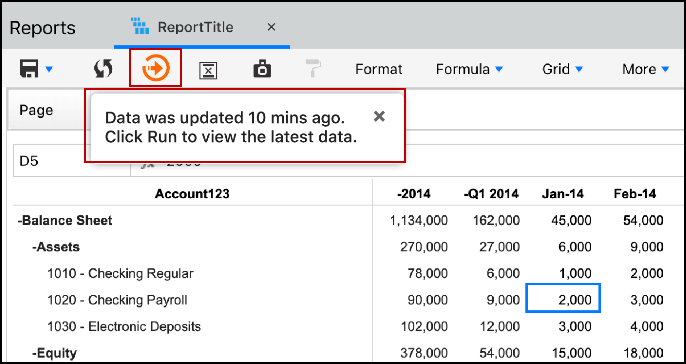
Prerequisite: Ivy needs to be enabled in the application. Contact the Planful support team of your customer success manager to know about how to get access to this functionality.
Automatic Data Refresh is triggered for the following scenarios:
When data is modified in templates
When data against the reference account column is deleted or the template column is deleted from the template
Manual Cube processing is required for the following scenarios:
When data is updated through the Simulation Engine
When data is refreshed for Actual or Closed periods
Data Seeding
When a Scenario is edited for the History or Closed periods
When a template is deleted
When an entity is mapped or unmapped within the template
When employee processing is done in the Workforce Planning templates
Global Fields input
Data loaded via DLR but Automatic Cube Refresh Setting not selected in Rule Settings.
Clear Data in DLR.
All Consolidation Processes except Standard Journals, Dynamic Journals, Elimination, Reclassification, and Non-Controlling interests.
Deletion of Journals or Journal lines needs manual processing.
The following table displays detailed information about the Automatic Data Refresh functionality.
| Category | Supported | Not Supported |
|---|---|---|
Reporting Areas | Financial | Workforce |
Processes/Templates | Global Template Single Copy (with or without Overwrite Mode) Global Template Entity Copy Line Item Allocation Block Capital Time Sets Initiatives Templated based HR Workforce Planning Actual Data Templates | All Data Integration All Consolidation Exchange Rates |
Scenario | Budget Forecast Plan Actual | Preload Budget Data Seeding Refresh Closed Periods Preload Data |
Actions | Input Lines Update Lines Delete Lines Allocations in Workforce Planning | Global Fields Input Delete Template Simulation Engine Template Entity Map / Unmap |
Dynamic Journals MTD data posting support
With this release, the MTD (Month-to-date) posting type entries enable you to post Dynamic Journals based on the month’s activity. The Month-To-Date (MTD) posting type entries for Dynamic Journals evaluate entries based on the month’s activity, whereas the Year-To-Date (YTD) posting type entries evaluate the entries based on the cumulative balance for the line items.

Business Value
The Month-To-Date (MTD) posting type entry for Dynamic Journals helps you to post Month-to-Date (MTD) balances by using a Dynamic Journal and evaluate entries based on the month's activity.
In Practice: Add a new Dynamic Journal
- In the Consolidation Control Panel, under Processes, click Dynamic Journals. The Dynamic Journals grid appears.
- Click the Add icon. The Add Dynamic Journal dialog box appears.
- On the Properties tab, specify the required information for the following fields:
- In the Code field, enter a code of your choice.
- In the Name field, enter a Dynamic Journal name.
- In the Period field, select the month and year range. During the selected time period, the Dynamic Journal is active.
- In the Posting Type list box, select the MTD or YTDposting type.Note:MTD (Month-to-date) evaluates entries based on the month’s activity; whereas, YTD (Year-to-date) evaluates the entries based on the cumulative balance of the line items.
- In the Reporting list box, select whether the Journal is a Dynamic JE (CC) or a Dynamic JE(LC). A journal can be in common currency or in local currency.Note:A local currency is often used by a company's subsidiaries and then converted to a common currency for consolidated reporting purposes.
- If you are adding an Unbalanced Journal, select the Unbalanced Journal check box. In Unbalanced Journals, debits are not equal to the total of the credits.
- To navigate to the Journal Entry tab, click Next or click the Journal Entry tab. The grid displays segment columns based on the application configuration and user's security. To set up a journal entry, perform the following steps:
- To add a new row, click Add.
- To set up the values for each column, do any one of the following:
- Specify the required values directly in the UI.
- Paste the copied line items from an MS Excel spreadsheet to the journal entry grid.
You can copy or paste all values, including description, segments, and debit or credit values. Use shortcut keys (Ctrl+C and Ctrl+V) to perform this action.
- To build a formula for the journal entry, perform the following steps:
- Click Rule in the journal entry row. The rule pane appears.
- Build a formula by using Simple Rule or Advanced Rule:
- Simple Rule —For the dimensions for which you want to select a member, open the selection pane and select the member.
- Advanced Rule —In the left side box, expand the member hierarchy, select the member, and then click the Add icon. Repeat the same procedure to select the function in the right side box. Click the tick (√) icon to verify the syntax of the formula.
- To save the rule, click Save
- Click Save.

